
Gregory the Illuminator is the patron saint and first official head of the Armenian Apostolic Church. He was a religious leader who is credited with converting Armenia from paganism to Christianity in 301.

The Armenian Apostolic Church is the national church of the Armenian people. Part of Oriental Orthodoxy, it is one of the most ancient Christian institutions. The Kingdom of Armenia was the first state to adopt Christianity as its official religion under the rule of King Tiridates III of the Arsacid dynasty in the early 4th century. According to tradition, the church originated in the missions of Apostles Bartholomew and Thaddeus of Edessa in the 1st century.

Armenians are an ethnic group native to the Armenian Highlands of Western Asia.

The Armenian Catholic Church is one of the Eastern particular churches sui iuris of the Catholic Church. They accept the leadership of the Bishop of Rome, known as the papal supremacy, and therefore are in full communion with the Catholic Church, including both the Latin Church and the 22 other Eastern Catholic Churches. The Armenian Catholic Church is regulated by Eastern canon law, namely the Code of Canons of the Eastern Churches.
Catholicos, plural Catholicoi, is a title used for the head of certain churches in some Eastern Christian traditions. The title implies autocephaly and in some cases it is the title of the head of an autonomous church. The word comes from ancient Greek καθολικός, pl. καθολικοί, derived from καθ' ὅλου from κατά and ὅλος, meaning "concerning the whole, universal, general"; it originally designated a financial or civil office in the Roman Empire. The name of the Catholic Church comes from the same word - however, the title "Catholicos" does not exist in its hierarchy.
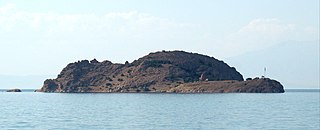
Akdamar Island, also known as Aghtamar or Akhtamar, is the second largest of the four islands in Lake Van, in eastern Turkey. About 0.7 km² in size, it is situated approximately 3 km from the shoreline. At the western end of the island, a hard, grey, limestone cliff rises 80 m above the lake's level. The island declines to the east to a level site where a spring provides ample water.

Gandzasar is a 13th-century Armenian Apostolic cathedral near the village of Vank in the Martakert Province of the self-proclaimed Republic of Artsakh, de jure in the Kalbajar District of Azerbaijan. It has historically been the region's most important church. One of the best pieces of Armenian architecture of the mid-1200s, the building is best known among scholars for its richly decorated dome. The monastery also is an exact prototype of the ruined Khamshi Monastery near the village of Martuni in Gegharkunik, in the Getik gorge. It was built as a Catholicos monastery from Aghvan in the 13th century.

Holy Savior Cathedral, commonly referred to as Ghazanchetsots (Ղազանչեցոց), is an Armenian Apostolic cathedral in Shusha, known to Armenians as Shushi, in Azerbaijan. It is the cathedra of the Diocese of Artsakh of the Armenian Apostolic Church.

Saint Hripsime Church is a seventh century Armenian Apostolic church in the city of Vagharshapat (Etchmiadzin), Armenia. It is one of the oldest surviving churches in the country. The church was erected by Catholicos Komitas to replace the original mausoleum built by Catholicos Sahak the Great in 395 AD that contained the remains of the martyred Saint Hripsime to whom the church is dedicated. The current structure was completed in 618 AD. It is known for its fine Armenian-style architecture of the classical period, which has influenced many other Armenian churches since. It was listed as a UNESCO World Heritage Site along with other nearby churches, including Etchmiadzin Cathedral, Armenia's mother church, in 2000.

Armenian architecture comprises architectural works with an aesthetic or historical connection to the Armenian people. It is difficult to situate this architectural style within precise geographical or chronological limits, but many of its monuments were created in the regions of historical Armenia, the Armenian Highlands. The greatest achievement of Armenian architecture is generally agreed to be its medieval churches and seventh century churches, though there are different opinions precisely in which respects.
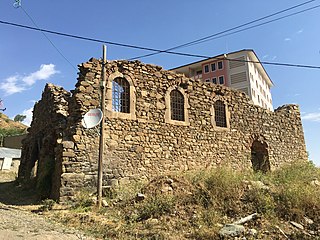
Surp Marineh Church was one of eight churches existing in town of Moush before the Armenian Genocide. Surp Marineh was the most notable church in whole Tarawn region of Historical Armenia, and was known as "Katoghike". Currently it is in a ruinous state and only parts of the outer walls still stand.

Tsitsernavank is a fifth-to-sixth century Armenian monastery in the Lachin District of Azerbaijan. The monastery is within five kilometers of the border of Armenia's province of Syunik.

The Armenian Patriarchate of Jerusalem also known as the Armenian Patriarchate of Saint James is located in the Armenian Quarter of Jerusalem. The Armenian Apostolic Church is officially recognised under Israel's confessional system, for the self-regulation of status issues, such as marriage and divorce.
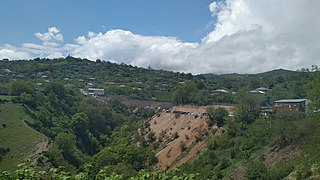
Haterk or Hasanriz is a village de facto in the Martakert Province of the self-proclaimed Republic of Artsakh, de jure in the Kalbajar District of Azerbaijan. The village has an ethnic Armenian-majority population, and also had an Armenian majority in 1989.

The Church of the Red Gospel or Shamkoretsots Sourb Astvatsatsin Church is a ruined 18th century Armenian church in the Avlabar district of Old Tbilisi, Tbilisi, Georgia.
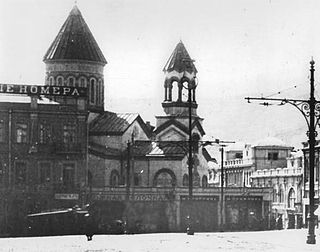
Kamoyants Saint Gevork Church was an Armenian Apostolic church in Tbilisi, Georgia. It was destroyed in 1937-38 by order of Lavrentiy Beria along with 10 other churches in Tbilisi.

Saint Mary Church, Holy Mother of God Church or Surp Mariam Asdvadzadzin Church is an Armenian Apostolic church in Tabriz, East Azerbaijan Province, Iran completed in 1785. It is the largest and oldest Christian church in Tabriz and a notable centre for Armenian national and religious ceremonies held by the Armenian community of Tabriz.
The Holy Trinity Church or Surp Yerrortut'yun Church is a historical Armenian Apostolic temple in the former Armenian quarter called Hoshnudiye of the Western Turkish town of Eskishehir. It was turned into an adult theater after the Armenians of the town were deported and killed during the Armenian Genocide.
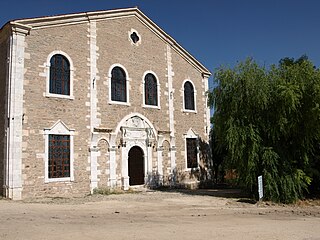
The Holy Trinity Church or Surp Yerrortut'yun Church is a historical Armenian Apostolic temple in the former Armenian quarter of Sivrihisar in the western Turkish province of Eskişehir. It was used as a store after the Armenians of the town had been deported and killed during the Armenian Genocide. It is one of the biggest churches in Anatolia.
The Second Council of Dvin was a church Synod or ecumenical Council held in 554 in the city of Dvin.

















